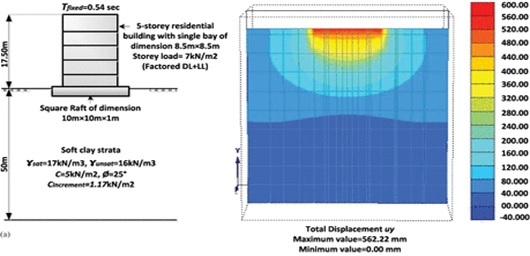Sustainable Foundation System for Alluvial Region

DOI:
https://doi.org/10.54060/jmce.v3i2.18Keywords:
Rigid raft Foundation, Safe bearing capacity of soil, Conventional approach, Soil pressureAbstract
A structure resting on soil having low bearing capacity and where differential settlement due to erratic nature of soil is expected, raft foundation is recommended to cope-up with mixed or poor ground condition and simultaneously to transfer heavy loads to ground while controlling the differential settlement. The essential task in the analysis of a raft foundation is the determination of the distribution of contact pressure underneath the raft which is a complex function of the rigidity of the superstructure, raft itself and sup-porting soil. The IS: 2950 (Part I)-1981 recommends the analysis based on the assump-tion of liner distribution of contact pressure. In this paper, an attempt has been made to design a raft foundation based on its geotechnical analysis. An extensive survey of re-search works devoted to study the geotechnical parameters affecting the behavior of raft foundation is carried out with detailed experiments raft foundations are increasingly being recognized as an economical and effective foundation system for high rise build-ings. This paper sets out some principles of design for such foundations, including de-sign for the geotechnical ultimate limit state, the structural ultimate limit state, and the serviceability limit state. Attention will be focused on the improvement in the foundation performance due to the raft being in contact with, and embedded within, the soil.
Downloads
References
L. S. Beedle, M.M. Ali, P. J. Armstrong, “The Skyscraper and the City: Design Technology and Innovation,” Books Lewiston NY: The Edwin Mellen Press ISBN 0773453334, vol.13, no.14, pp.1-856, 2007.
F. Feng, Design and Analysis of Tall and Complex Structures,” Butterworth-Heinemann Elsevier ISBN: ISBN 978-0-08-101121-8, pp.1-295, 2018.
D. Challinger, “From the Ground Up: Security for Tall Buildings CRISP Report,” Alexandri VA: ASIS Foundation Research Council, pp.1-44, 2008.
K. Chatterjee & D. Choudhary, “Soil liquefaction and bearing capacity at a building site in Lucknow,” India under earthquake conditions Disaster Advances, vol.8, no.5, pp.16-28, 2015.
M. Cubrinovski, “Foundations on Deep Alluvial Soils Technical Report Prepared for the Canterbury Earthquakes Royal Commis-sion University of Canterbury,” Christchurch, pp.1-44, 2011.
M. Gregor, “Wight Reinforced Concrete Mechanics and Design,” 4th edition University of Michigan, pp.1-1177, 2012.
M. D. Braja, “Principles of Foundation Engineering,” 6th edition by Nelson Chris Carson, pp.1-815, 2007.
A. Ansari, “Design of Reinforced Concrete Structure,” Qatar University, 2008.
M. D. Braja, “Principles of Foundation Engineering,” 6th edition by Nelson Chris Carson, pp.1-815, 2007.
S. Nakai, H. Kato R. Ishida, et al., “The Load Bearing Mechanism of Piled Raf Foundation During Earthquake,” Proceedings Third Ujnr Workshop on Soil Structure Interaction March, Melono Park California USA, pp.1-17, 2004.
B. V. Bakholdin, “Piled Raft Foundations Design and Characteristics of Construction Procedures”, Soil Mechanics and Founda-tion Engineering, vol.40, no.5, 2003.
A. S. Balasurbamaniam, E. Y. N. Oh, Q. M. Bui, et al., “Parametric Study on Piled Raft Foundation in Sand Using Numerical Model-ling, “eleventh east Asia pacific conference on structural engineering and construction Taipei Taiwan, pp.1-651, 2014.
S. Bhattacharya, S. P. G. Madabhushi, “A Critical Review of Methods for Pile Design in Seismically Liquefiable Soils,” Bull Earth-quake Engineering, vol.6, pp.407-446, 2008.
H. K. Engin, E.G. Septanika & R. B. Jui, “Estimation of Pile Group Behavior Using Embedded Piles,” 12th international Conference Iacmag, pp.3231-3238, 2008.
C. S. Kame & V. A. Sawant, “A Parametric Study on Raft Foundation,” The 12th International Conference of International Asso-ciation for Computer Methods and Advances in Geomechanics (IACMAG) Goa India, pp.3077-3085, 2008.
D. K. Maharaj, “Non-Linear Finite Element Analysis of Piled Raft Foundations,” Geotechnical Engineering, no.157, pp.107-113, 2015.
D. K. Maharaj, “Analysis of Piled Raft Foundation,” Seminar on Design of Pile Group and Pile C Mackerle Jaroslav,” Fem and Bem in Geomechanics: Foundations and Soil Structure Interaction A Bibliography Finite Elements in Analysis and Design, vol.22, pp. 249-263, 1996.
P. Kitiyodom & T. Matsumoto, “A Simplified Analysis Method for Piled Raft and Pile Group Foundations with Batter Piles,” In-ternational Journal for Numerical and Analytical Methods in Geomechanics, vol.26, pp.1349-1369, 2002.
H. G. Poulos, “Simplified Design Procedure for Piled Raft Foundations,” Deep Foundations, 2002.
H. G. Poulos, “Piled Raft and Compensated Piled Raft Foundations for Soft Soil Sites,” Advances in Designing and Testing Deep Foundations, 2006.
H. G. Poulos & G. Bunce, “The Piled Raft Foundation for the Burj Dubai Design and Performance,” IGC ferreco terzaghi oration, pp.1-16, 2008.
P.C. Vergese, “Foundation engineering, PHI Learning, pp.1-567, 2005.
IS 1904:1986 code for practice, “Design and construction of foundations in soil,” pp.1-24, 1987.

Downloads
Published
How to Cite
CITATION COUNT
Issue
Section
License
Copyright (c) 2023 Devesh ojha, Dr. Rajendra Kr. Srivastava

This work is licensed under a Creative Commons Attribution 4.0 International License.
























